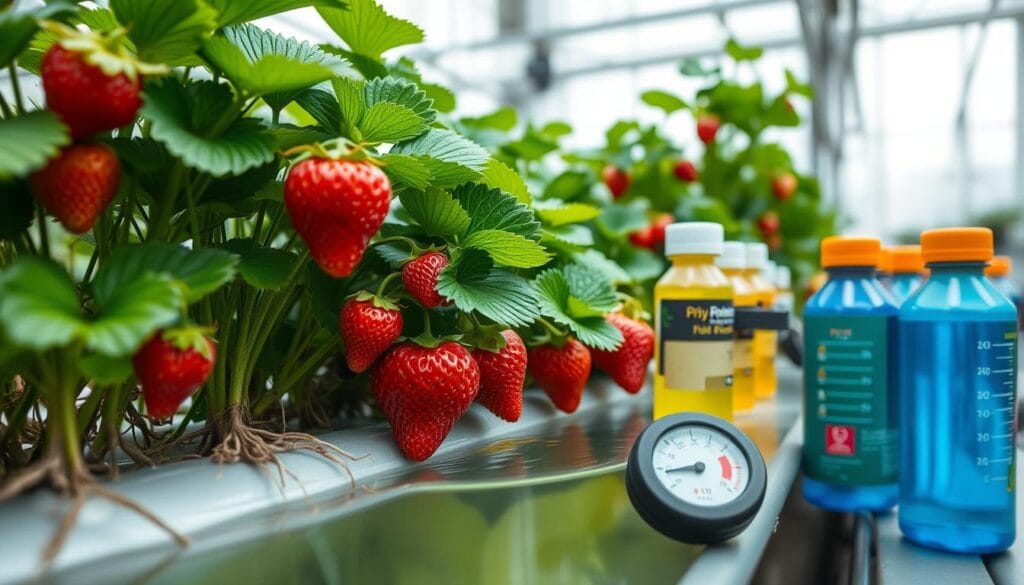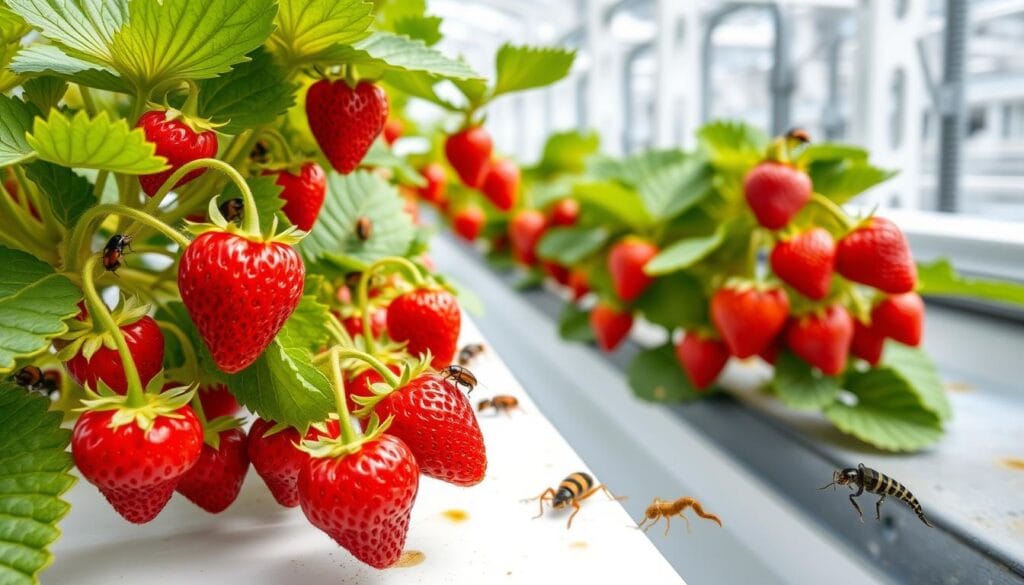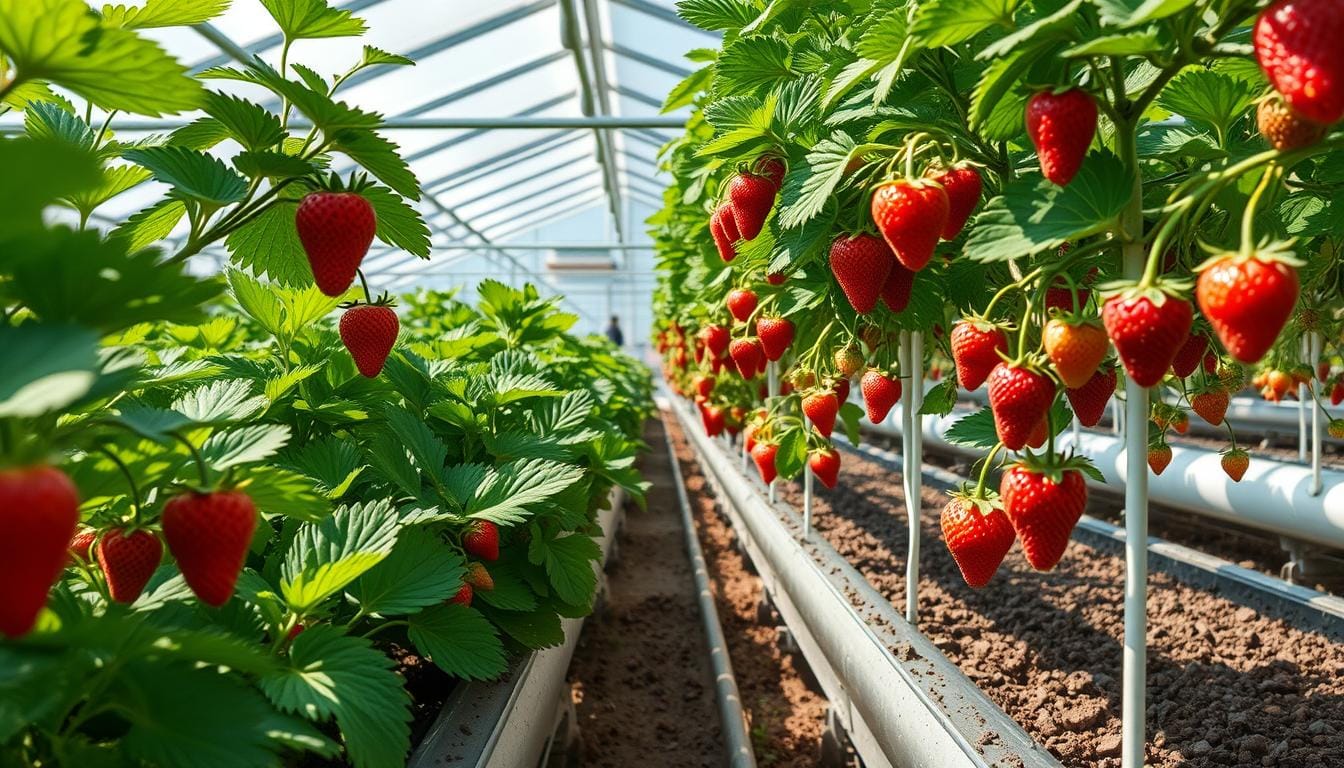Growing strawberries has always been my passion. But, discovering hydroponic strawberry growing changed everything. Traditional soil-based methods were frustrating, with unpredictable yields and lots of water.
Hydroponic strawberry care is a game-changer. It turns gardening into a precise, efficient art. By removing soil and controlling nutrients, you can grow sweeter, healthier strawberries all year. You can even do it in your home or a small space.
This guide will show you the five key steps to master strawberry hydroponics. You’ll learn how to harvest delicious, vibrant berries with ease and joy.
Key Takeaways
- Hydroponic systems reduce water consumption by up to 90%
- Precise nutrient control enhances strawberry plant health
- Year-round cultivation is possible with indoor hydroponic setups
- Controlled environments minimize pest and disease risks
- Space-efficient growing techniques maximize strawberry production
Understanding Hydroponic Strawberry Cultivation
Hydroponic strawberry cultivation is a new way to grow tasty strawberries without soil. It changes how we grow strawberries by making a perfect environment for them. This ensures your plants remain healthy and thrive.
Soilless growing has many benefits for farmers and gardeners today. It gets rid of soil problems and lets you control what plants eat and how they grow.
Benefits of Soilless Growing
- Eliminates soil-borne diseases
- Reduces pest management challenges
- Provides direct nutrient access to plant roots
- Enables precise environmental control
Year-Round Production Advantages
Hydroponic strawberry cultivation means you can have fresh strawberries all year. You don’t have to wait for seasons to pass. This way, you can grow strawberries anytime, no matter the weather.
| Production Metric | Soil-Based Growing | Hydroponic Growing |
|---|---|---|
| Annual Harvest Cycles | 1-2 Seasons | Continuous Production |
| Water Usage | High | Up to 90% Less |
| Crop Yield | Standard | Higher Yields |
Space Efficiency Benefits
Hydroponic systems are great for saving space. Vertical growing techniques and small setups let you grow strawberries in tight spots. This is perfect for city living, balconies, or small indoor areas.
“Hydroponics transforms limited spaces into productive strawberry gardens, bringing fresh produce closer to home.” – Agricultural Innovation Quarterly.
By choosing hydroponic strawberry growing, you can have fresh strawberries all year. This method is efficient and good for the planet.
Setting Up Your Hydroponic Strawberry System
Creating a successful hydroponic strawberry system needs careful planning and the right equipment. Your setup affects the quality and amount of strawberries you get.
When designing your hydroponic setup, consider these critical components:
- Choose a stable location with a consistent temperature
- Ensure access to electrical outlets for lighting
- Select the appropriate hydroponic system type
- Prepare necessary growing materials
Popular hydroponic system options for strawberries include:
| System Type | Pros | Best For |
|---|---|---|
| Nutrient Film Technique (NFT) | Excellent water efficiency | Small to medium-scale growers |
| Deep Water Culture (DWC) | Simple maintenance | Beginner hydroponic gardeners |
| Dutch Bucket System | Scalable design | Large strawberry production |
Key requirements for your hydroponic strawberry system include:
- LED grow lights (14-16 hours daily)
- Nutrient solution with pH between 5.5-6.5
- Temperature control (65-75°F)
- Proper air circulation
“Success in hydroponic strawberry cultivation begins with a well-planned and meticulously maintained system.” – Hydroponic Farming Expert.
By investing time in setting up your hydroponic strawberry system correctly, you’ll create an environment that promotes healthy plant growth and abundant fruit production.
Selecting the Right Strawberry Varieties for Hydroponics
Selecting the right strawberry varieties for hydroponics is crucial for success. Not all strawberries grow well in soilless systems. Knowing the traits of different varieties helps you get the best harvest.
For hydroponic strawberry growing, pick varieties that do well in controlled spaces. Your choice affects fruit quality, taste, and plant health.
Day-Neutral Strawberry Varieties
Day-neutral strawberries are top picks for hydroponics. They keep producing fruit all the time, no matter the day’s length. They do great in indoor spaces, giving you berries all year.
- Albion: Known for exceptional sweetness and disease resistance
- Seascape: Produces large, flavorful berries in various conditions
- San Andreas: Robust variety with excellent fruit quality
Everbearing Strawberry Options
Everbearing strawberries give you multiple harvests a season. They usually have two to three big crops a year.
| Variety | Flavor Profile | Yield Potential |
|---|---|---|
| Quinault | Sweet, mild | High |
| Ozark Beauty | Rich, classic strawberry taste | Medium to High |
| Eversweet | Extremely sweet | Consistent |
Popular Commercial Cultivars
Commercial growers often choose specific strawberry varieties for hydroponics. These are picked for their growth, disease resistance, and steady fruit production.
“In hydroponics, choosing the right variety is the cornerstone of successful strawberry cultivation.” – Hydroponic Growing Expert.
When picking strawberry varieties for hydroponics, think about flavor, size, disease resistance, and your growing space. Try different types to find the best fit for your system.
Creating the Optimal Growing Environment
To grow hydroponic strawberries well, you need to pay close attention to several factors. Success comes from creating the right conditions for your plants. This means making sure the environment is just right, like their natural home, but with the benefits of hydroponics.
When setting up your hydroponic strawberry garden, remember these key points:
- Temperature range: 65-75°F (18-24°C)
- Humidity levels: 60-80%
- Light exposure: 12-16 hours daily
- pH balance: 5.5-6.5
“The key to thriving hydroponic strawberries is precision in environmental management.” – Hydroponic Agriculture Expert.
Lighting is very important for your strawberry plants. LED grow lights with the appropriate spectrum can support their growth effectively. Red spectrum light (650-665nm) helps with photosynthesis, flowering, and fruit growth.
| Environmental Factor | Optimal Range | Impact on Growth |
|---|---|---|
| Temperature | 65-75°F | Promotes steady growth and fruit production |
| Humidity | 60-80% | Prevents plant stress and supports nutrient absorption |
| Light Duration | 12-16 hours | Maximizes photosynthesis and fruit development |
Air circulation is also key for your hydroponic climate control. Good airflow stops fungal problems and keeps the environment steady. Use quality fans and monitoring tools to keep your strawberries healthy and fruitful.
Hydroponic Strawberry Care
Keeping your hydroponic strawberries healthy needs a careful plan for daily, weekly, and monthly tasks. With the right care, your system can become a top strawberry producer.
Good care for your hydroponic strawberries means more than just watering. It’s about creating the perfect conditions for growth and fruit.
Daily Hydroponic Care Essentials
Every day, you need to check on your strawberries. Here’s what to do:
- Check the nutrient solution levels
- Test the pH and electrical conductivity (EC)
- Look for signs of stress or disease on the plants
- Make sure they have the right light and temperature
Weekly Care Schedule
Weekly tasks keep your system running smoothly and your plants strong:
- Trim off runners and extra leaves
- Clean the system parts
- Change the nutrient solutions
- Check the water flow
Monthly System Checks
Every month, do a deep check to keep everything running well:
| Area | Task | Frequency |
|---|---|---|
| Reservoir | Deep clean and sanitize | Monthly |
| Equipment | Calibrate and replace worn parts | Monthly |
| Growing Area | Thorough cleaning and disinfection | Monthly |
“A consistent care routine ensures a rich and abundant hydroponic strawberry harvest.”
By following these steps, you’ll make sure your hydroponic strawberries have the best chance to grow and produce great fruit.
Nutrient Management and pH Balance

Mastering hydroponic strawberry nutrients is key to growing sweet, healthy berries. Success depends on managing nutrients well and keeping the right pH balance.
Understanding what your strawberry plants need is the first step. A balanced hydroponic fertilizer with the right NPK ratio is essential for growth and fruit.
“Healthy strawberries start with the right nutrients.” – Hydroponic Farming Experts
Key Nutrient Requirements
- Nitrogen (N): Supports leaf and stem growth
- Phosphorus (P): Enhances root development and flower formation
- Potassium (K): Improves fruit quality and plant resilience
- Calcium: Strengthens cell walls and prevents fruit disorders
- Magnesium: Essential for chlorophyll production
pH Balance Strategies
Keeping the right pH balance is vital for nutrient absorption. Your hydroponic strawberry system should aim for a pH between 5.5 and 6.5.
| pH Level | Nutrient Absorption | Correction Method |
|---|---|---|
| Below 5.5 | Reduced nutrient uptake | Add potassium hydroxide |
| Above 6.5 | Limited mineral availability | Use phosphoric acid |
Regularly check your nutrient solution’s electrical conductivity (EC). Aim for an EC between 1.4 to 2.0 mS/cm for the best nutrient availability for your strawberry plants.
Practical Nutrient Management Tips
- Use filtered or distilled water for mixing nutrient solutions
- Replace nutrient solution every 7-14 days
- Clean your nutrient reservoir frequently
- Use a digital pH meter for accurate measurements
Pro tip: Consistent monitoring and adjustment are key to successful hydroponic strawberry cultivation.
Managing Light and Temperature Requirements
Successful hydroponic strawberry cultivation depends on precise environmental control. Your plants’ health and productivity rely on mastering light and temperature management. Understanding these critical factors is key to optimizing your hydroponic strawberry system for maximum yield.
Light Duration and Intensity
Hydroponic strawberry lighting is vital for plant development. Your strawberry plants need specific light conditions to thrive:
- Provide 12-16 hours of light daily
- Use full-spectrum LED grow lights for indoor systems
- Ensure consistent light distribution across plants
“Light is the primary driver of photosynthesis and fruit production in hydroponic strawberries.” – Agricultural Research Expert.
Temperature Control Methods
Temperature control is key for optimal growing conditions. Keep air temperatures within these ranges:
- Daytime: 65-75°F (18-24°C)
- Nighttime: No lower than 55°F (13°C)
- Use climate control equipment like fans and heaters
Seasonal Hydroponic Adjustments
Successful hydroponic strawberry cultivation requires adaptive strategies throughout different seasons. Implement these seasonal adjustments for consistent plant performance:
- Winter: Increase artificial heating and supplemental lighting
- Summer: Enhance ventilation and cooling systems
- Monitor humidity levels between 50-70%
By carefully managing light and temperature, you’ll create an ideal environment for your hydroponic strawberries to flourish year-round.
Preventing and Treating Common Issues

Keeping your hydroponic strawberries healthy means watching for pests and diseases closely. You need to check your plants often and act fast if you see any problems.
“When it comes to hydroponic strawberries, prevention outweighs the need for cure.”
It’s key to use integrated pest management (IPM) to protect your strawberries. Regular checks help you spot issues early.
- Check plants daily for signs of pest infestation
- Monitor leaf color and plant structure
- Maintain optimal growing conditions
- Use sterile equipment to prevent disease spread
Keeping the right environment can help a lot. Keep humidity levels between 50-70% to stop fungal diseases like powdery mildew.
| Common Pest | Detection Size | Preferred Location |
|---|---|---|
| Aphids | 1/8 inch | New growth stems |
| Spider Mites | Pin-head size | Leaf undersides |
| Whiteflies | Tiny insects | Leaf undersides |
Act fast if you find pests or diseases in your hydroponic strawberry system. Isolate sick plants and use organic treatments to stop damage.
- Use neem oil for natural pest control
- Implement biological controls
- Ensure proper air circulation
- Remove infected plant material promptly
By using these pest control and disease prevention methods, you’ll make a great place for your hydroponic strawberries to grow.
Conclusion
Hydroponic strawberry farming is a new way to grow strawberries that’s good for the planet. It lets growers make amazing fruits in a very efficient way. This method uses hydroponics to control the growing process, making sure the strawberries are both plentiful and full of nutrients.
Starting a hydroponic strawberry farm is great for the environment. It uses up to 90% less water than old farming ways. This helps save water and gives you healthy strawberries. Plus, it keeps plants safe from diseases and makes them grow better.
Hydroponic strawberry systems are great for anyone, whether you grow at home or on a big scale. Plants like Albion and Seascape grow well here, giving you berries in 60-90 days. They are sweet and healthy, thanks to the perfect care they get.
Choosing hydroponics means you’re part of a big change in farming. It’s all about using less and making better food. Your choice helps make farming better for the planet, one strawberry at a time.

